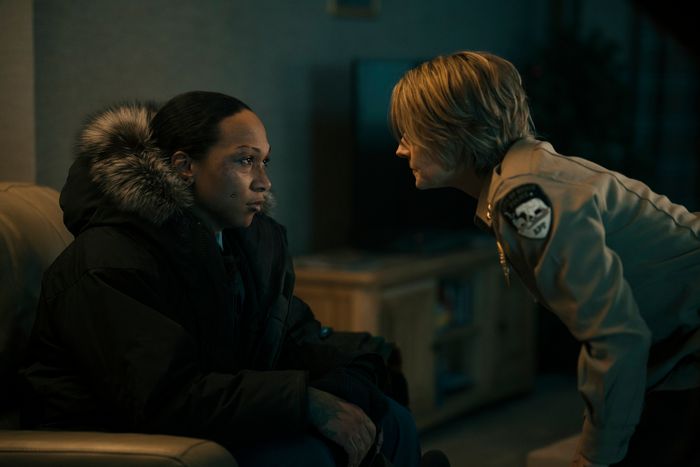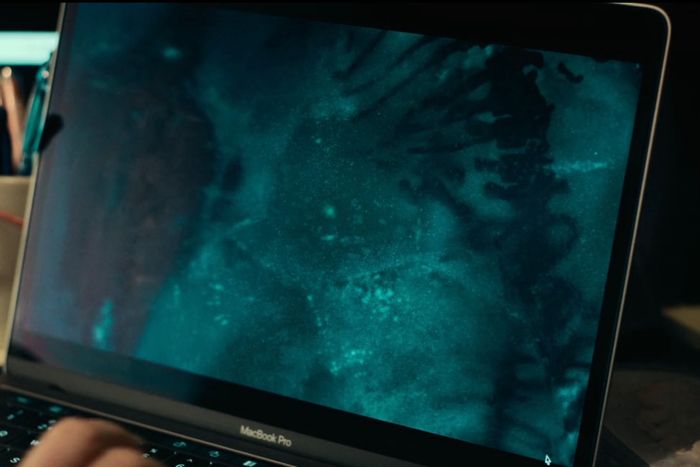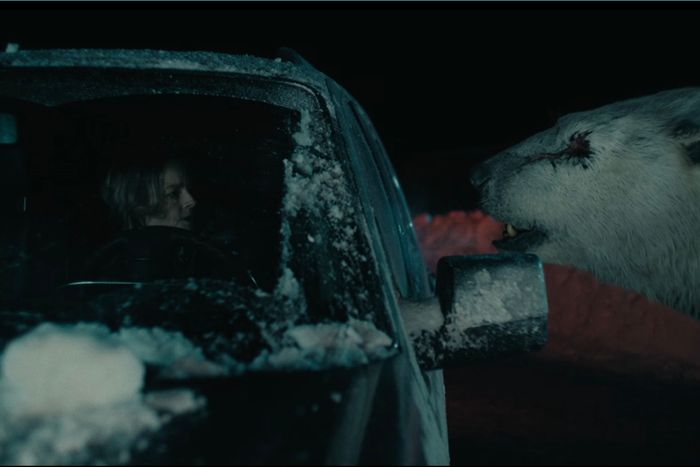
This week’s True Detective: Night Country is very sad. It’s sad primarily because — and at this point I feel obligated to say spoiler alert — Navarro is unable to save her sister, Julia. Even though Navarro helps Julia check into mental-health facility the Lighthouse on Christmas Eve, the troubled young woman removes her clothes, folds them carefully just like the Tsalal scientists seemingly did, and walks straight into the sea.
That story line is just one of several in the fourth hour of Night Country that places extra emphasis on loss, grief, and the possibility that the dead continue to exist in some closely adjacent sphere. You’ll never guess who doesn’t buy into that idea. That’s right, it’s that shining ray of light known as Chief Liz Danvers, who helpfully insists that “The dead are gone,” right before Navarro reveals that her sister died mere hours ago. (Oops.)
Danvers may think the dead are gone, but I am here to respectfully counter that assertion with: Nuh-uh. This episode makes this season’s strongest case yet that the specter of former entities exist alongside the living in Ennis, and when I say specter of former entities, I’m not referring to sad white men who spend Christmas Eve alone watching Elf. (The only sadder thing in this episode than Julia’s death is the sight of John Hawkes standing at the airport with a very hastily chosen stuffed bunny for his Russian fiancée, who never gets off the plane because she was never real in the first place. Way, way, way harsh, Tai.)
Instead of just talking about ghosts, let’s figure out what they, and other details, in this week’s Night Country signify?
Hey, look. Another orange.
Last week’s column discussed the significance of the oranges that appeared in “Part 3,” and how, per The Godfather, that fruit is often considered a harbinger of death. (For more on how oranges work in The Godfather, either rewatch The Godfather or go talk to one of the Kens from Barbie.) That seems to be how it’s working in Night Country, too. Like her older sister before her, Julia sees an orange roll across the floor and land at her feet during her very brief stay at the Lighthouse. Julia doesn’t live too much longer after that orange sighting for reasons that involve the next topic of discussion.
I’m not convinced that the oranges mean death for whoever interacts with them, or if they simply suggest that spirits are present. Navarro seems certain that she’s bound for the grave soon — “It takes us. One by one. And you know who’s next,” she tells Danvers — and the fact that she’s also seen foreboding oranges would suggest she’s right. But recall the advice that Rose gave Navarro in the second episode: “The thing about the dead is some of them come and visit because they miss you. Some come because they need to tell you something that you need to hear. And some of them just wanna take you with them. You need to know the difference.” Navarro may think the dead are coming for her, the way they did for her mother and sister. But as I’ve said previously, maybe they just need to tell her something.
Once again, I must ask whether the oranges add up to a real theory, or are just eerie? Their eeriness is well-established, but I don’t think the oranges are a theory in and of themselves. They’re mostly a reminder that the living and the deceased are sharing a lot of real estate in Ennis.
Holy shit, what’s up with the scary-ass wet woman?
This terrifying apparition appears under Julia’s bed right after the ominous orange rolls into the picture. Understandably Julia is frightened of this damp creature — ghost? hallucination? A vision of her future self or her late mother? — and appears to be lured toward the sea by its presence, similar to the way Travis Cohle was called to the water before he drowned. (Remember what I mentioned before about the sirens in the story of Odysseus? This sopping-wet freakazoid could be a siren.)
Navarro sees this same woman when she and Danvers investigate the dredges, as well as in that flashback to the William Wheeler incident, where she has a vision of being pointed at by this same woman in desperate need of a hair dryer. Despite coming face-to-face with the specter while Danvers is chatting up Otis, though, Navarro is still alive. Which is why I don’t think this thing wants her dead. If it did, it would have already made that happen.
It seems fair to assume this figure is also the “she” the scientists were referring to when they said “She woke up” and possibly the last thing they saw before they croaked. But who is she? I honestly don’t know, but I know who she calls to mind. When I see creepy women with long black hair and dripping-wet clothes, I immediately think of Ringu, the 1998 Japanese film adapted for American audiences as The Ring. Directed by Hideo Nakata, its most chilling character is Sadako, a young woman who emerges from a well in a videotape that curses its viewers to die within seven days. The film eventually reveals that in real life, Sadako was trapped in a well and left to die there by her father; the representation of her on the videotape — the “curse” — was the manifestation of her rage, which became so powerful it could literally kill.
One of Nakata’s subsequent films, Dark Water, dealt with somewhat similar subject matter: A mom and her daughter move into a new apartment complex where the mother keeps having visions of a young girl who went missing a year earlier. Eventually she realizes the girl drowned in a water tank on the roof of the building. Like Night Country and Ringu, this movie is drenched in water imagery and features a ghost who can control the people she haunts. The scary-ass wet women in both films are the type of dead people who want to drag the living to the other side with them. That doesn’t mean the one in Night Country wants the same thing from everyone she seeks out, but it’s worth considering the parallels since director Issa López’s visuals seem deliberately reminiscent of Nakata’s work.
Do all these sopping, spooky ladies add up to a real theory, or are they just eerie? At the moment, they’re more eerie and interesting than anything else, but watch this space.
Blue is not the warmest color.
Perhaps we should have figured Julia was not long for this world based purely on the color of her hair. It’s a faded-out blue, practically identical to the color that Annie K. was sporting not long before her demise.
Is this a theory or just eerie? Just a spooky little observation.
We brought Ariana Grande into this last week, and now it is Billie Eilish’s turn.
Eilish has been a presence in every episode of True Detective: Night Country thanks to the show’s theme music, her 2019 track “Bury a Friend.” The song’s unsettling vibes and lyrics all feel very apropos of Ennis. “When we all fall asleep, where do we go?” is an apt question for this show about endless days of darkness and the mysteries surrounding what happens to people after they pass. Notably, in a Rolling Stone interview, the singer said she wrote “Bury a Friend,” “from the perspective of the monster under your bed.” A monster under a bed: you mean the scary-ass wet lady that quite literally shows up under Julia’s bed? In an interesting coincidence, the video for “Bury a Friend” sees Eilish emerging from underneath a bed, looking a bit like a monster herself. Her hair is also colored a fading shade of turquoise that matches Julia’s and Annie K’s. Given those tie-ins, it seems meaningful that Eilish’s music pops up a second time in this episode, as the soundtrack to Julia’s walk toward the water. “You oughta know/That even when it’s time/You might not wanna go,” Eilish croons on the appropriately titled “Everybody Dies.” Kinda sounds like the song of a siren doesn’t it?
Does all this Billie Eilish business add up to a theory or is it just eerie? I think these are just slightly creepy coincidences that deepen the significance of the show’s music choices without explaining anything substantive. But, like, in a fun way!
And now an extremely brief history of ice caves.
Based on the video found on Annie K.’s phone, Danvers and Navarro conclude that Annie was in an ice cave when she died and that her body was dumped in town to “send a message.” They visit Adam, Liz’s ex-lover/science teacher/expert on Tsalal stuff, who spots whale bones embedded in the cave that are “probably prehistoric.” This suggests Annie’s ice cave was naturally formed and has been there for years and years, although as Adam notes, the caves that exist near Ennis were boarded up a while ago. Based on this information about ice caves in the United States, those could be glacier caves, which are present in Alaska and constructed naturally from glacial runoff. The tunnels in these caves are constantly in flux, suggesting they are not terribly stable, which tracks with Adam’s warning about entering them without a seasoned guide. Perhaps the Tsalal scientists were using the ice caves to access the microorganism that can purportedly extend human life?
As I was perusing this scientific abstract, another type of ice cave caught my eye: mine caves. Those also exist in Alaska and are formed “from ice deposits in mines and tunnels”; their size is “dependent on human activity.” Could the ice caves be related to the mine somehow?
Do the ice caves add up to a theory or are they just eerie? They definitely look beautiful and also eerie. But the caves seem more significant than that. The idea that Annie’s body was moved from one of those caves to a more discoverable location to “send a message” suggests her death was part of a cover-up of some kind. The power outages that link Annie’s case to the deaths of the scientists also suggest someone may have been trying to shut down the scientists’ work. It’s not clear why at this point, but Navarro’s belief that the mine is somehow related to all of this is starting to sound less and less like a crackpot theory.
Should Ennis start installing crosswalks for this jaywalking polar bear or what?
That’s obviously a matter the cops don’t have time to consider right now. But the reappearance of the actual polar-bear version of the stuffed animal that belonged to Liz’s son — we now know his name was Holden — feels significant because Liz is the one who sees it out on the road this time. I still don’t think the bear is real, but rather, a lodestar urging Navarro and Danvers to keep pursuing their leads. The fact that Liz tosses Holden’s stuffie out into the snow during her argument with Navarro, which takes place immediately after her one-eyed polar-bear sighting, tells us how unsettled she is by the fact that she also sees strange things in Ennis. She wants to deny that, partly because of her practical nature and partly because if she allows herself to believe, even a little bit, that spirits are real, she might yearn to connect with Holden again.
Does the presence of the polar bear constitute a theory or is it just eerie? It mostly emphasizes a psychic connection that Danvers and Navarro seem to share, even if Navarro is far more in touch with that side of herself.
You know what this show needs? One more weird dude with connections to the Tsalal Research Center. Please give a warm welcome to Otis Heiss!
Prior discovers the existence of Mr. Heiss while searching medical records for people with injuries similar to the ones afflicting the Tsalal crew. (How does Prior find the time??) Otis is a jackpot find: Both of his corneas were burned (yet another person with a visual impairment who probably knows some shit!), his ear drums were ruptured, and he suffered from self-inflicted bites while hospitalized after an accident “with no determined cause.” This all seems totally normal and no cause whatsoever for suspicion!
But wait, it gets better: Otis seems to exist off the grid. He’s a German national with no social-security number, no credit cards, a criminal record, and apparently a drug habit. Oh, and according to Adam, he’s the guy who mapped the caves. When Danvers and Navarro go searching the dredges for Clark, it’s Otis they find, and he’s not doing well. He tells them Clark is hiding in “the night country” and that “We’re all in the night country now.” The way he uses that term suggests that Clark and everyone in Ennis has officially entered some liminal space between normal reality and a potentially terrifying great beyond, which we pretty much already knew. But Otis’s cloudy eyes have seen some things that may be important.
Does Otis’s existence add up to a theory or is he just eerie? We need to hear more from Otis before we can formulate any theories. But I think he has some information, or at least a way to find Clark, that will be useful to Danvers and Navarro.
Finally: What’s Elf got to do with it?
As previously mentioned, both Hank Prior and Ted Connelly wind up alone on Christmas Eve watching the movie Elf, a funny parallel that highlights their complementary roles as police-captain thorns in Danvers’s side. But why Elf, as opposed to another Christmas movie? Well, It’s a Wonderful Life is too obvious and sad. Home Alone is too childish. Oh, also, Elf is a Warner Bros. film and we all know who owns HBO.
But that practicality aside, Elf feels like a thematically resonant choice. At its core, this is a movie set during the holidays, about a man (Buddy the Elf) trying to connect with the father he never got the opportunity to know. Night Country is sort of similar in that regard. It’s also a Christmas-set story about mothers missing their connection with children they’ve lost (Danvers and Holden), fathers trying to connect with kids despite the daily obstacles presented by their demanding jobs (Prior and his son Darwin), and guardians trying to save their charges before it’s too late (Navarro and Julia). Admittedly it’s not as funny as Elf and doesn’t feature a cameo appearance from Santa. But there’s more of a link than one might immediately assume.
Does Elf add up to a theory or is it just eerie? It’s neither, it’s just a smartly chosen pop-cultural reference, which is becoming Night Country’s specialty.









